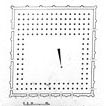| |
Introduction: The Mosque
Professor Dodds
|
|
Architecture and Early Islam:
This building type serves as a place of prayer,
but also a community center. It is not an exclusive, sacred
space a priori. A mosque is not necessary for prayer, but
it is preferable that all members of an Islamic community
pray together on Friday. The extraordinary growth of Early
Islam is predicated in part on the democratic nature of religion
and society: all are equal in the eyes of God; prayer is an
individual interaction with God; there is no priesthood, no
intermediary between man or woman and God. The will of the
umma, or community, reflects God's will. So the early mosque,
as the center of community identity, developed in a form which
reflects this concern with democracy: the hypostyle
plan, with its forest of columns has no axis, no hierarchical
space. In the earliest mosques, like Kufa,
there is no axis or hierarchy.
 |
 |
 |
 |
 |


Map of Early Islam
|
|


Kufa II, plan
|
|


Mosque Plan |
Because those who pray face Mecca (in earliest
Islam, they faced Jerusalem), the largest part of the prayer
hall, or roofed area, often faces Mecca.
The wall that faces Mecca is called the Qibla wall. Often
the Qibla wall is distinguished by a niche in the thickness
of the wall called the Mihrab. The mihrab indicates the Qibla,
and is also thought to represent the presence of the prophet,
One never prays to the niche, nor to the prophet. The Mihrab,
like the Kaaba in Mecca, is an empty space.
Hypostyle mosques also have a courtyard called
a Sahn, around which are shaded porticos: Riwaqs. The call
to prayer in the early period was accomplished from platforms
on the mosque roofs. Later, the minaret
was developed as a symbol of the presence of Islam. Smaller
minarets in time became associated with the call to prayer.
(See: Andre Grabar, The Formation of Islamic Art, rev. and
enlarged ed., New Haven and London, 1987.)
In the 7th century, there was a conscious attempt to resist
highly monumental, luxurious and rhetorical expressions in
mosque building. But, in particular with the Great Mosque
of Damascus,
opulent and monumental schemes became more and more the favored
means of expression of Umayyads
and Abbasids
as they established new hegemonies.


Great Mosque of Damascus, Aerial view
|
|
| |
 |
Architectural Decoration:
There can be no images of animate beings—animals
or humans—in
the decoration of the mosque. Islam is an aniconic
religion: one that resists such images. Though various artistic
expressions in Islamic secular art will develop around figural
representation, such images are never present in mosques.
At the Great Mosque of Damascus, an enormous urban space was
glazed with green and blue mosaics executed by Byzantine mosaicists.
These are similar to Christian images of paradise—gardens,
rivers, trees and palaces—but
without the images of saints which would inhabit them in a
Christian context. Representational art without figural representation
might however have proved to limiting.
Mosque decoration—in
other parts of Damascus and in other mosques throughout the
Islamic world—developed a series of approaches instead
to abstract ornamentation. Whether geometric, vegetal, or
trompe
l'oeil, these decorative schemes engaged the viewer intellectually.
briefing | image index | resources
home page | site
image index | site resources
media center for art history, archaeology and historic preservation
| columbia university
|
|

